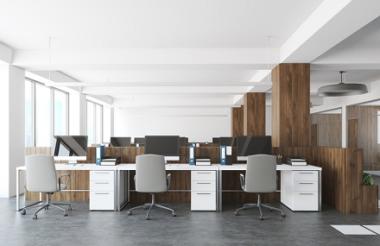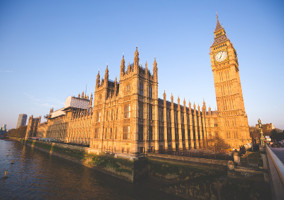The Covid-19 pandemic has led to a rise in flexible working and it has become increasingly clear that accessibility and inclusion are key to a successful workplace. Many inclusive adaptations which people with disabilities have been fighting for years for have suddenly been adopted and embraced by employers, such as remote working and improved video conferencing technology.
Sightsavers is one of the only international NGOs in the UK with Disability Confident Leader status and we have found this history of prioritising disability inclusion meant that we were able to quickly adapt to suddenly having our offices closed and everyone working from home.
Our HR department does a tremendous job in ensuring that all areas of our employment are disability inclusive, from compliance with the Equality Act, to recruitment and retention of staff with disabilities and making sure that everyone has reasonable accommodations. Being more inclusive has not only increased our focus on staff wellbeing and diversity, but it also meant we had some systems in place which helped us to cope with the huge changes to working life.
We believe it is vital this continues as we move out of the pandemic. As we rebuild our workplaces post Covid-19, we should all take the opportunity to reshape the way we work so that businesses are accessible for everyone. The International Labour Organisation notes that disability inclusion at work can increase innovation, since “employees with diverse experiences have different approaches to problem solving”. Building back inclusively is building back better.
We’ve compiled five tips that employers, leaders and managers can use to make your workplace more inclusive.
1. Provide training and raise awareness
One of the first steps to being inclusive is by increasing knowledge and awareness among staff, and we encourage businesses to set up internal groups to do this. Our Social Inclusion Working Group, of which I am a member, brings together staff from across Sightsavers to promote commitment to inclusion and accessibility and raise awareness of issues surrounding it. Over the past few years the group has conducted numerous disability awareness training sessions for staff, and senior management agreed to make participation in the training mandatory for all new starters.
We have also developed an online awareness-raising platform with tips to include colleagues with disabilities, organised courses in British Sign Language and arranged a series of seminars inviting external experts to talk to staff about their experiences and share their knowledge on disability inclusion and accessibility in the workplace. Our HR team has also rolled out global guidelines for line managers to support staff with disabilities.
These actions encourage discussions around disability in the office that people often shy away from. They also help managers within the organisation gain a better understanding of how their team members work and the workplace modifications they might need.
2. Embrace flexible working and make use of technology
When Covid-19 broke out, remote working became a necessity for everyone. But for those with chronic illness or disability, this is not new, as many thrive with more flexible working conditions.
On the one hand, this requires an inclusive culture within the organisation, which is responsive to the needs of all employees, and in particular those with disabilities and chronic conditions. On the other hand, it requires a solid digital infrastructure. Thankfully, these days there is plenty of technology available to accommodate this.
Sightsavers has invested in systems like Virtual Private Networks (VPNs) and Microsoft 365, which allow people to connect to the company’s networks from wherever they are in the world. We choose conference and virtual technology that specialise in captions for those with hearing impairments (such as Microsoft Teams), provide braille keyboards and make sure that all new laptops have mics and webcams built in. These are some straightforward technological tools which make a real difference for people with disabilities and they don’t always have to be expensive.
3. Include accessibility in design
By including everyone’s needs in design from the start, systems run smoother and work is made easier.
Communications accessibility is important to ensure that nobody is left out of the picture, and so our templates and branding have been designed with this in mind. For example, using colours that can be easily read by those with colour blindness, or making sure text is appropriate for screen readers. We have launched our brand accessibility guidelines which encourage staff to make sure our content is consistent and as accessible as possible. In Britain and the EU, it’s also the law.
4. Take mental health seriously
Life can be stressful enough even without a global pandemic going on and we recommend support systems are put in place to counter this. Long before Covid-19, our CEO, with guidance from our senior HR business partners team, launched a wellbeing task force with resources for all staff. They developed a team of mental health first aiders (all employees) to signpost staff to appropriate help when they are experiencing a mental health issue or emotional distress.
Our online Wellbeing Hub includes a subscription to the meditation app Headspace, a confidential telephone counselling service (included free from our insurance provider) and a stress-busting tips message board. Even small things, such as regular updates from our CEO on what resources are available, can help create a more open and welcoming working environment where staff feel more comfortable asking for help.
We have recently launched a Disabled Employee Network at Sightsavers and hope to use it to share resources and information that promote the wellbeing and welfare of people with disabilities working in our organisation.
5. Look for guidance and collaborate
There are lots of tools and guidelines available to companies looking to be more inclusive. Along with all the resources linked to above, some others we use regularly are:
- Disability Confident Employers – this UK government scheme supports employers to make the most of the talents disabled people can bring to the workplace.
- Jobcentre – they provide guidance on hiring people with disabilities.
- Web Content Accessibility Guidelines (WCAG) - a set of recommendations for making web content more accessible, primarily for people with disabilities. Sightsavers have developed our own screen reader testing solution based on these.
- Microsoft Accessibility Checker – this tool helps to make sure office content is easy for people of all abilities to read and edit.
- Apple accessibility – a guide to all of the accessibility features of Apple technology
The process of inclusion is never complete and despite our achievements so far, we always have more to do and learn. We welcome thoughts and ideas from other organisations and are happy to share more details and learnings with others who are willing to become employers of choice for people with disabilities.
So, if you are working in this area, feel free to contact me with any tips, questions or feedback, and let’s work together to build more inclusive societies.
Kate Bennell is organisational inclusion coordinator at Sightsavers UK












